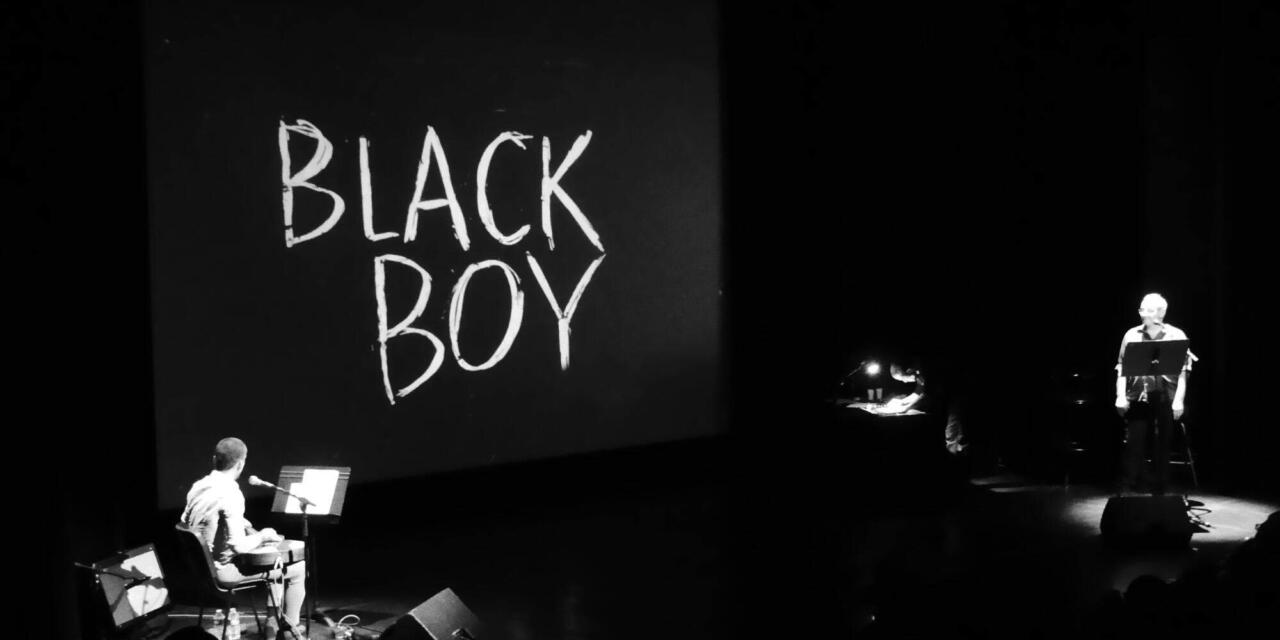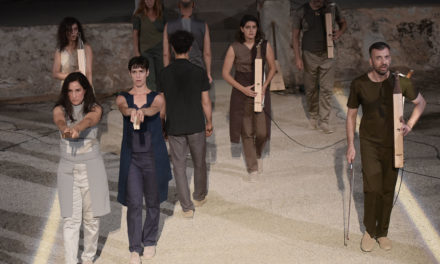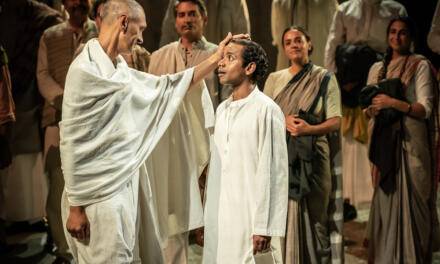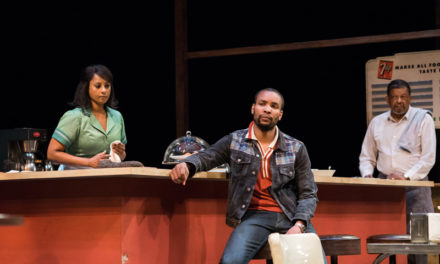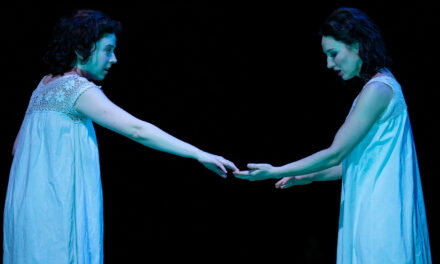What do you do when you are blown away by a show, and yet you know that there is something inherently troubling in its premise? Or how about, what do you do when you go to see a play about a black writer, Richard Wright (1908-1960), framed by white men, all prepared to sneer at this setup, and find yourself carried away by the production? And then the lurking feeling surfaces: who am I—a white critic enmeshed in the same web of privileges as these theatre-makers—to criticize? Is it ok to love a play and feel troubled by this reaction? These are just some of the questions that were brought to my mind when watching the stunning production, Black Boy, inspired by Wright’s autobiography of the same name, adapted to the stage by Jérôme Imard as part of the Parisian suburb theatrical Compagnie du Mantois.
Adapting it Wright
Black Boy began in pre-COVID times (just before the lockdown hit actually) and has played to audiences over two hundred times in the past couple of years. Its popularity is no mystery; the premise is rather spellbinding. An illustrator (Benjamin Flao) performs live drawing, projected on a central screen, to reflect the scenes evoked by the narrator (Imard) of Wright’s autobiography; both (stage left) feed off of the extraordinary soulful blues of guitarist Olivier Gotti (seated stage right), who in turn retains close attention on the narrator to heighten dramatic tension with beating and syncopated rhythms when needed.
This is a three-pronged “call and response” chorus to reconstruct the story of Richard Wright, a jazz technique which makes for compelling intermedial theatre. Richard Wright was one of the many African American artists who emigrated to France in the twentieth century, a contemporary of James Baldwin and Chester Himes. The “call and response” setup on the stage honors Wright by taking inspiration from another part of this transatlantic history: French re-circulations of African American jazz and blues.[1]
The show is also upfront, both in the scenographic configuration and in the press pack, that this is a black man’s story recreated by white men: “We know well that he over there with the microphone is not a little black boy but a white actor.”[2] If it is becoming increasingly the norm to acknowledge one’s privilege in talking about race, these performers appear to be doing something “right”—it’s very rare indeed to start talking about racial identity, especially if white, in this country, which is so attached to universalism. This production is not naïve about Wright’s story. The press pack recognizes that the racial inequalities that existed in his time remain today.
The adaptation of the original 1945 autobiography also fleshes out, with dramaturgical deftness, the core of Wright’s autobiography: his Sisyphean struggle against white supremacy, growing up black in the Jim Crow era Deep South. The performers discard the harrowing opening of the 1945 book which might detract from this central theme, when the author as a boy receives the beating of his life from his parents after setting the family home ablaze in an accident. Instead, the creators of Black Boy, the show, open with the author’s discovery that being white means having power: the illustrator sketches Wright as a boy glancing up to his mother, asking why the prisoners of a chain gang he sees are all black, discovering in her response that “justice” is all-white. Humorously easing into this hard-hitting narrative, the boy describes the black-and-white striped prisoners as “elephants”, confusing the word with “zebra”.
The adaptation dwells on the white gaze. Richard and his co-workers are subjected to humiliating behavior, acting out caricatures for the entertainment of and money from whites. In one scene, which takes place in an elevator, a pre-drawn overlay of an overweight cigar-smoking white man and a horrified, wide-eyed Richard Wright forms the backdrop. In front of them a flat puppet, an early Mickey Mouse, moves about the scene. This is Wright’s friend who acts the goofy fool to get 25 cents from the rotund white man. The show visually rehearses blackface caricature, desacralizing Disney, and its reinforcement of racist stereotypes for the pleasure of early white cinema-going audiences.[3]
Indeed, as I found myself reclining deeper into my seat, I got the distinct impression that something cinematic was being stirred in my perceptual habits, despite the live music, words, and drawing. This was as comforting as it was unsettling. I was lulled to a feeling that the screen was far removed from my lived time (as in cinema), yet was also reminded of Dani Syder-Young’s point in her recent book Privileged Spectatorship: racial hegemony feasts off of white spectators’ sense of personal remove, on the impression that we are nothing like those awful people we see in plays about race—in this case, the whites that drive Richard Wright away from the Deep South to Chicago at the end of the story (aged 19, in 1927).[4]
Paradox and potential
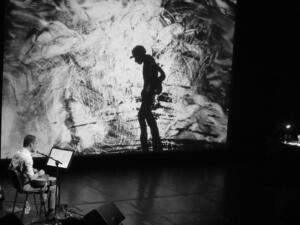
Black Boy, Compagnie du Mantois (c) Dominique Michel.
That said, there is something resolutely (a)live that remains in the production’s performative mode of drawing. Watery paint splotches (yellow, like bursts of sunshine when Richard discovers books) splay out and oscillate with the pulse of the guitar emanating from across the stage. Egregious histories are redrawn (not just blackface but the Ku Klux Klan and a lynching scene) but the illustrator’s flow resists audience fixation on them. The illustrator’s pen marks figures and a cloth then promptly rubs them out. Perception turns protean. What we think are the three triangular hats of a Ku Klux Klan mob become the shirt and tie of an upside-down Richard Wright, seemingly in a doorway until the page is turned 180 degrees to reveal the aspiring author in his bed, despairing at the material barriers he faces as a black writer in a white world.
Our gaze, constantly on the move, cannot fixate on stereotypes even as these are conjured up. Black blotches, monstrous formations, become dignified black silhouettes. The production ends with Richard Wright “walking” towards us. A small silhouette is drawn over to reveal another bigger version of Wright, then another even bigger, until the whole scene is awash with black paint. The illustrator then dabs the page with a cloth, letting white streaks permeate through black, giving the impression of blackness becoming luminous. This is Richard Wright’s final Eureka moment of self-affirmation on his own terms, not on those of white people, as black light floods the projected page and he flees the Deep South for Chicago.
This moment of “black light” recalls a long-established tradition in African American visual art—from Faith Ringgold to Haki Madhubuti, Bob Crawford, and Billy Abernathy—to reverse Enlightenment dichotomizations of lightness and whiteness as sources of purity and the truth, and blackness as the center of obscurity and untruth.[5] The illustrator’s flirtation with the concept also draws attention to missed opportunities to decolonize white perceptual habits: at various points in the performance, blackness flooded the scenes to imply violence (as in the case of a woman who is beaten) and sinister goings-on (the transition from the Ku Klux Klan to the lynching scene). Had these black shrouds become white, perhaps the show might have struck up a more truthful relationship with the real sinister force: “the hostile white light of Western history”, which has been laid bare in African American art, visual histories, philosophy, and fiction.[6]
But, it is much easier to criticize others than to look inside. Perhaps what runs so deep about Black Boy is its unapologetic messiness, which struck a chord with my own complicated position as a white theatre critic of this play about a black man. The production openly acknowledges its white framing yet recreates, lovingly, with passion and devotion, the story anyway. The limits of this (and my) white worldview should not be forgotten or ignored. Yet this was a production that I hated to love, a guilty pleasure that confronts me with some uncomfortable home truths.
[1] Marc Lapprand has for instance written on the French magazines of the mid-century that gave a platform to African American jazz: Jazz Hot, La Gazette du Jazz and Jazz News. Lapprand focuses on Boris Vian’s writings on jazz. Vian was also a translator of Richard Wright. Marc Lapprand, “Boris Vian, passeur d’Amérique”, https://www.transatlantic-cultures.org/fr/catalog/boris-vian-passeur-d-amerique (accessed 13 May 2022).
[2] Compagnie du Mantois, Press Pack, p. 3. Downloadable here: https://www.theatre-traversiere.fr/espace-pro/#espace-pro-espace-presse (accessed 12 May 2022).
[3] For instance: https://www.nbcnews.com/think/opinion/disney-s-racist-cartoons-won-t-just-stay-hidden-vault-ncna998216 (accessed 12 May 2022)
[4] Dani Synder-Young, Privileged Spectatorship: Theatrical Interventions in White Supremacy (Evanston: Northwest University Press, 2021).
[5]Margo Natalie CRAWFORD, “Black Light on the Wall of Respect: The Chicago Black Arts Movement.” Ed: Lisa Gail Collins, Margo Natalie Crawford. New Thoughts on the Black Arts Movement (New Brunswick: Rutgers UP, 2006). 23- 42.
[6] Ibid, 30.
This post was written by the author in their personal capacity.The opinions expressed in this article are the author’s own and do not reflect the view of The Theatre Times, their staff or collaborators.
This post was written by Lara Cox.
The views expressed here belong to the author and do not necessarily reflect our views and opinions.

